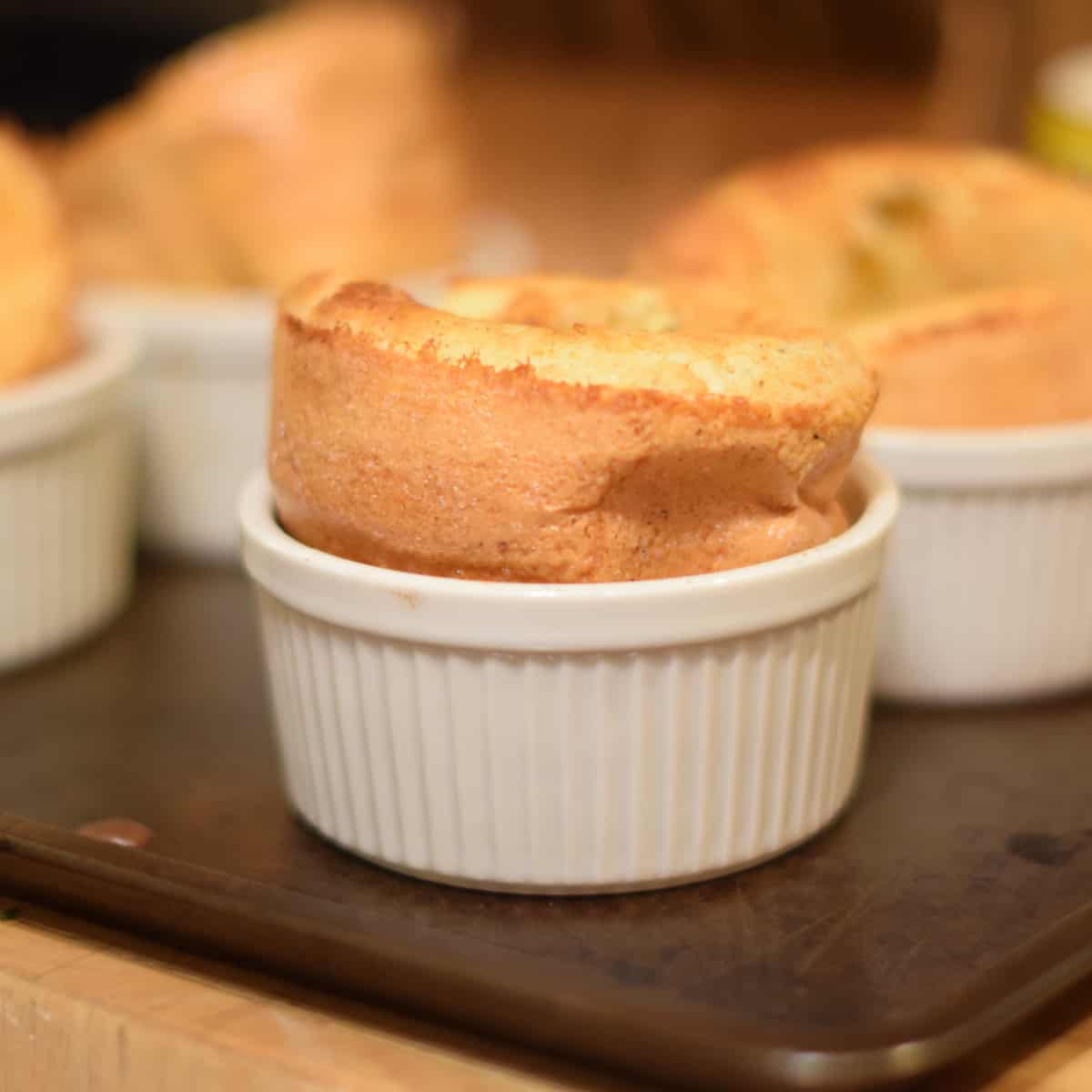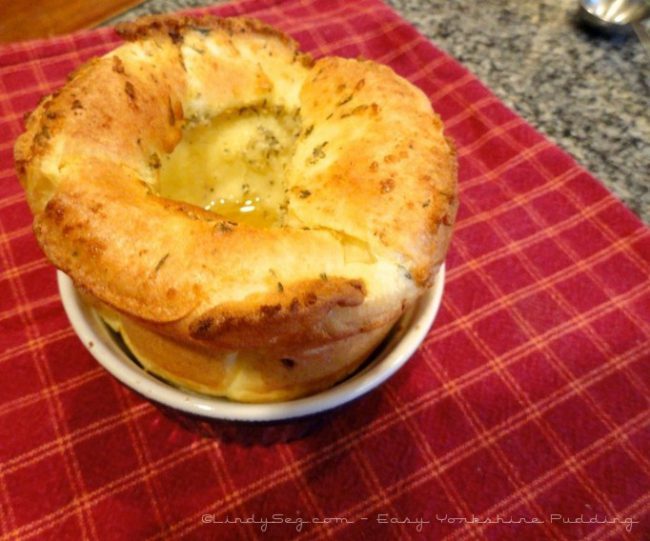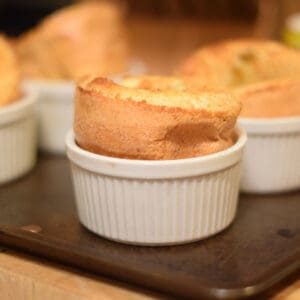"Easy Yorkshire Pudding is really easy to make and has the "pudding" consistency that I think any good Yorkshire pudding should have. The trick? Whisk in some ice cold water right before putting it into the hot oil"

A history of the making of perfect Easy Yorkshire Pudding
If you prefer not to read my story, hit the jump to recipe button at the top of this page
The first time I had Yorkshire Pudding was many years ago at the Sky Lounge Restaurant at LAX. After I had been served my Prime Rib and "Biscuit" I asked where my Yorkshire Pudding was. "Right there" responded our waiter, pointing to my biscuit. I had no idea.
Years later, I went to Christmas Eve dinner with my husband's family. Their traditional dinner was a Beef Tenderloin with Yorkshire pudding, which was made in the same baking dish the meat had been cooked in. It never rose properly, so it was sort of a flat, doughy thing. Not the best.
I suggested that we try to use individual ramekins, making the pudding more like what I had at the airport. Put in some drippings, get the ramekin nice and hot, add the batter and...well, voila, we had nice individual "puddings" but still, they seemed more like popovers than anything pudding-like. So why call them Yorkshire Pudding? They should be called Yorkshire Popovers.
The trick? Add a tablespoon of cold water to the batter right before the final whisk and pour into the hot ramekin...
As time went on, I tried to take this rather interesting, yet, fairly tasteless, pop over to the next level, a tasty, savory pudding level. I found a new recipe, a simple easy Yorkshire pudding recipe. Combining my use of a ramekin, and my newfound trick, I finally found a perfect, easy Yorkshire Pudding recipe.
The trick? After allowing the batter to rest for at least 30 minutes, add a tablespoon of cold water right before the final whisk and pour into the hot ramekin.

The recipe is simple in principle. An equal volume of eggs, milk, and flour. A pinch of salt, my addition of a pinch of dried thyme, and lard, beef dripping or vegetable oil. Generally, I put a little extra olive oil into the pan with the drippings I get from my meat so I have enough to put into the ramekin, allowing the oil to get a bit of beefy flavor, but you don't need to. The magic is the water. Cold water, 1 tablespoon per 2 eggs. Perfectly crisp outside, golden brown, with a pudding-like interior. Delicious!
LindySez: This recipe is written for four servings using a ½ cup ramekin. Only want two, half it. Want more, double it. Just remember it's equal amounts, in volume with 1 tablespoon cold water added at the end, for every two eggs used. Also, please note, if you use a smaller size than the ½ cup ramekin, such as a muffin tin, you will want to decrease the amount of oil you use in the bottom of the tin, otherwise, it may overflow.
The total depth of the oil should not exceed ⅛th of an inch deep.

Easy Yorkshire Pudding
Equipment
Ingredients
- 4 large eggs broken and measured in a measuring cup (so, if the eggs measure ¾ cup, then the milk and flour will both be also measured at ¾ cup)
- Equal amount of whole milk to eggs
- Equal amount of sifted all-purpose flour to milk and eggs
- Pinch of salt (about ¼ teaspoon) dash of pepper (here's a good place to use white pepper)
- Large pinch of dried thyme
- 4 tablespoons beef drippings vegetable oil, or combination of both
- Special Equipment: 4 ½ cup in size ramekins
Instructions
- Put the eggs and milk into a large mixing bowl, add the salt and thyme; whisk well. Add the sifted flour and whisk until you have a fairly thin (sort of resembling a thick cream) lump-free batter. Allow this to rest, at room temperature for 30 minutes to 1 hour. (This is an important step, you need to allow the glutens in the flour to relax. If leaving for more than 1 hour, keep in the refrigerator. Bring to room temperature before continuing)
- Heat the oven to 450°F. Place your ramekins into the oven for 10 minutes; add the fat (1 tablespoon per ramekin) and return to the oven for 5 -7 minutes more, or until the fat is hot. (if the fat is already hot from you roasting pan, you can shorten the time to 3 - 5 minutes - you want it sizzling hot).
- Give the batter a good whisk, then add 2 tablespoons COLD water, whisk again. Pour into the prepared HOT ramekins, to ⅓ full; return quickly to the oven.
- Cook for 15 - 20 minutes, or until browned and puffy. Serve immediately.

Gary
If I were to make this recipe GF.
Would all ingredients remain equal parts substituting measure to measure (GF) flour + a pinch of arrow root in place of the ap flour?
LindySez
Truth Gary...I don't know. I don't cook GF so am not familiar with substitutions other than I thought most GF flours now had all the necessary elements to make the GF without any additions. If incorrect, then I would "assume" that any substitutions you make to your flour for other recipes would apply here. If you do make these, and make them GF please share back how they worked. Inquiring minds want to know. Cheers ~ Lindy